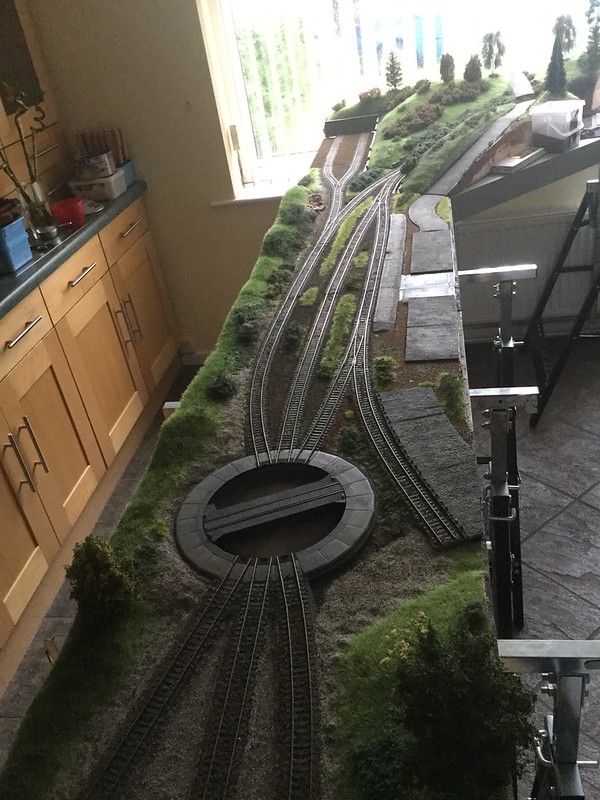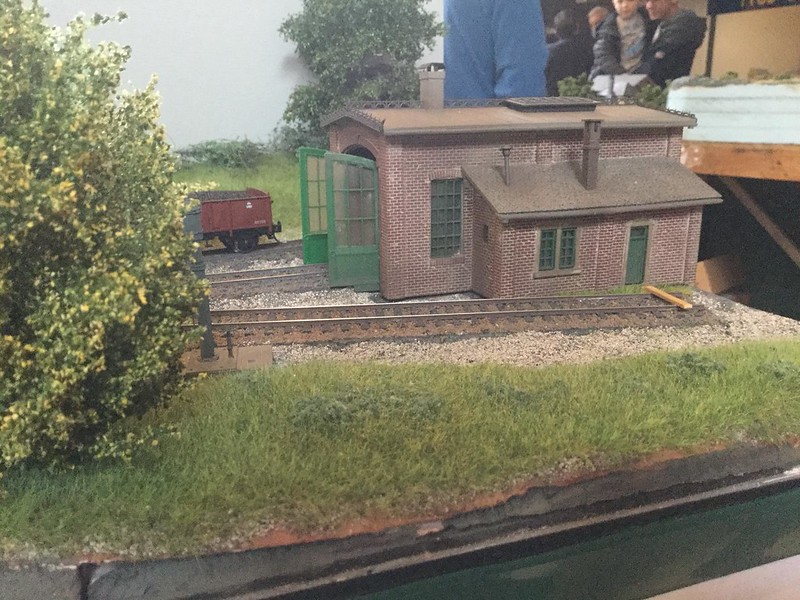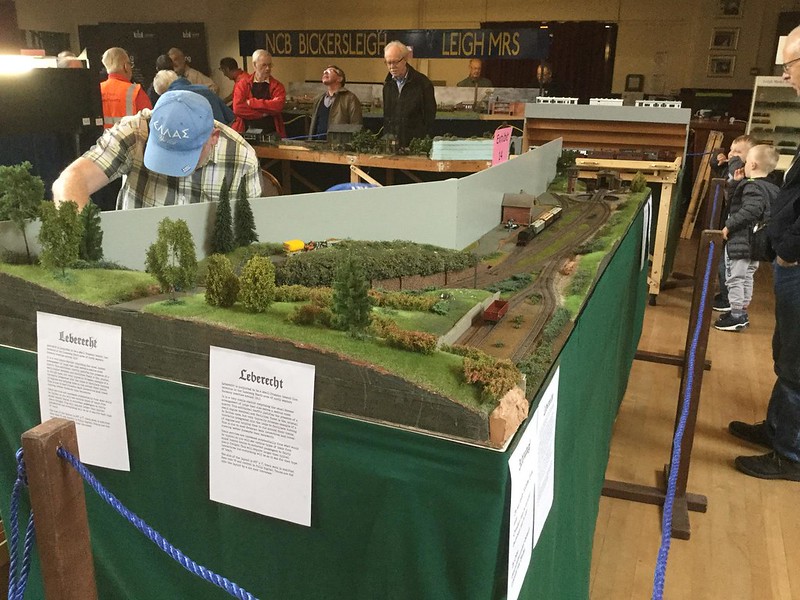allegheny1600
Western Thunderer
Now to try and describe the stress that I went through upon my return from holiday!
Despite having had a wonderful break away from everything, when my wife and I returned to the UK, my feelings of anxiety returned with a vengeance as there was so much still to do. We also had some rather rainy weather to contend with too that caused a delay in collecting the layout but I busied myself clearing the kitchen as my lovely wife Bev, had allowed me to assemble the layout here rather than down in the big shed. It meant that work could be carried out in comfort.
When I did get over to Doug’s and laid eyes on the layout, I was stunned! He really had done an excellent job, I must say.
After some discussion, we added some further vegetation to certain parts of the scenery and changed some grass colours to darker shades, other than that, I was very satisfied with how the scenery looked.
We then transferred the layout over to my kitchen and set it all up again. This at least was good practice for the exhibition.
 Leberecht by Allegheny1633, on Flickr
Leberecht by Allegheny1633, on Flickr
I now had to start working my way through the extensive list of jobs I had written whilst in Greece, the first job being to ensure greater reliability of the action of the points. My first thought was to superglue the actuating rod to the tie-bar. Big mistake! What had been inadequate performance previously was now rendered completely useless. Bev came to the rescue thankfully, with her suggestion for more substantial actuating rods, sourced from her jewellery making collection. A bit of filing and cutting later, the first new rod was installed and worked beautifully, thanks Bev! This was repeated for all the other points, what a relief when they all worked.
Next, I had to assemble the station building but first, I wanted to recreate mortar lines in the brickwork. Some folk use “Jif” but I had heard good reports about “Roberts Brick Mortar formula” so I gave it a go. Unfortunately, due to the pressures on my time, I left it longer than needed so it set harder than it should have been but scraping with a toothpick resolved this issue and I was quite satisfied with the results. It was then very quick and easy to assemble the flat-pack parts of the station building, I was very pleased with how it then looked. Small details still needed to be done but it was at a good state for the show, especially after I gave it a quick blast of weathering from my airbrush.
 Leberecht by Allegheny1633, on Flickr
Leberecht by Allegheny1633, on Flickr
 Leberecht by Allegheny1633, on Flickr
Leberecht by Allegheny1633, on Flickr
Boosted by this, I then gave the mortar treatment to the loco shed and all the components for the water tower, which I then assembled quickly but accurately - I’ve never built a building so fast! I hasten to add that I had built the loco shed previously, it was only the water tower I built in a hurry. These two were also treated to a quick airbrushing for a much improved appearance.
 Leberecht at Leigh show Sept 2018 by Allegheny1633, on Flickr
Leberecht at Leigh show Sept 2018 by Allegheny1633, on Flickr
 Leberecht at Leigh show Sept 2018 by Allegheny1633, on Flickr
Leberecht at Leigh show Sept 2018 by Allegheny1633, on Flickr
Whilst I was doing these jobs, I was also working on many other jobs, some of which caused a major meltdown like when I initially connected up my Roco Z21 digital controller. Previously during testing, I had always used my trusty NCE but I thought that Doug would prefer to use the Roco Multi-Maus, hence the Z21.
Unfortunately, it turned out that I had connected on of the serial leads into the wrong socket on the wireless (wi-fi) terminal so there were red lights flashing on the main black box! I thought this meant there was a major ‘short’ on the layout so panic ensued. Fortunately, Doug gave me a talk-down and, feeling calmer, I re-read the instructions, connected everything correctly and voila! We were in action and the electrics and points were now working as they should.
I also finally wired up the turntable and was very pleased when it worked perfectly, what a relief!
Having gotten so far, I really wanted to fit my Viessmann signal as I really love the action on these mechanisms but I only had a 12mm drill bit. I managed to enlarge the hole by waggling the drill bit but sadly, the signal went in at a slight angle, never mind! Unfortunately, I then discovered that the output of my Lenz accessory decoders was incorrect to drive my signal, Grr!
 Leberecht by Allegheny1633, on Flickr
Leberecht by Allegheny1633, on Flickr
Meanwhile, Bev was busy finishing the painting of the back-scene boards and also making a front ‘skirt’ from some green cloth that I had bought for my US layout but never got around to doing ‘properly’, this entailed cutting to the correct height, stitching the edges and fitting ’Velcro’ so the skirt can be added and removed easily.
 Leberecht at Leigh show Sept 2018 by Allegheny1633, on Flickr
Leberecht at Leigh show Sept 2018 by Allegheny1633, on Flickr
Also, Doug and Bev did some ’tidy up’ painting of the baseboard edges where there were still pink foam edges on display(!) along with additional ballasting right up to scenery sections, buildings and so on.
I had wanted to at least get my freight stock weathered before the show but time was running so late, I only had chance to make sure everything was fitted with Kadee couplings and the one loco I knew was iffy, got a clean of wheels and pick-ups.
By now, we had reached Friday tea time so it was time to get the layout over to the exhibition venue.
Until next time.
Despite having had a wonderful break away from everything, when my wife and I returned to the UK, my feelings of anxiety returned with a vengeance as there was so much still to do. We also had some rather rainy weather to contend with too that caused a delay in collecting the layout but I busied myself clearing the kitchen as my lovely wife Bev, had allowed me to assemble the layout here rather than down in the big shed. It meant that work could be carried out in comfort.
When I did get over to Doug’s and laid eyes on the layout, I was stunned! He really had done an excellent job, I must say.
After some discussion, we added some further vegetation to certain parts of the scenery and changed some grass colours to darker shades, other than that, I was very satisfied with how the scenery looked.
We then transferred the layout over to my kitchen and set it all up again. This at least was good practice for the exhibition.
 Leberecht by Allegheny1633, on Flickr
Leberecht by Allegheny1633, on FlickrI now had to start working my way through the extensive list of jobs I had written whilst in Greece, the first job being to ensure greater reliability of the action of the points. My first thought was to superglue the actuating rod to the tie-bar. Big mistake! What had been inadequate performance previously was now rendered completely useless. Bev came to the rescue thankfully, with her suggestion for more substantial actuating rods, sourced from her jewellery making collection. A bit of filing and cutting later, the first new rod was installed and worked beautifully, thanks Bev! This was repeated for all the other points, what a relief when they all worked.
Next, I had to assemble the station building but first, I wanted to recreate mortar lines in the brickwork. Some folk use “Jif” but I had heard good reports about “Roberts Brick Mortar formula” so I gave it a go. Unfortunately, due to the pressures on my time, I left it longer than needed so it set harder than it should have been but scraping with a toothpick resolved this issue and I was quite satisfied with the results. It was then very quick and easy to assemble the flat-pack parts of the station building, I was very pleased with how it then looked. Small details still needed to be done but it was at a good state for the show, especially after I gave it a quick blast of weathering from my airbrush.
 Leberecht by Allegheny1633, on Flickr
Leberecht by Allegheny1633, on Flickr Leberecht by Allegheny1633, on Flickr
Leberecht by Allegheny1633, on FlickrBoosted by this, I then gave the mortar treatment to the loco shed and all the components for the water tower, which I then assembled quickly but accurately - I’ve never built a building so fast! I hasten to add that I had built the loco shed previously, it was only the water tower I built in a hurry. These two were also treated to a quick airbrushing for a much improved appearance.
 Leberecht at Leigh show Sept 2018 by Allegheny1633, on Flickr
Leberecht at Leigh show Sept 2018 by Allegheny1633, on Flickr Leberecht at Leigh show Sept 2018 by Allegheny1633, on Flickr
Leberecht at Leigh show Sept 2018 by Allegheny1633, on FlickrWhilst I was doing these jobs, I was also working on many other jobs, some of which caused a major meltdown like when I initially connected up my Roco Z21 digital controller. Previously during testing, I had always used my trusty NCE but I thought that Doug would prefer to use the Roco Multi-Maus, hence the Z21.
Unfortunately, it turned out that I had connected on of the serial leads into the wrong socket on the wireless (wi-fi) terminal so there were red lights flashing on the main black box! I thought this meant there was a major ‘short’ on the layout so panic ensued. Fortunately, Doug gave me a talk-down and, feeling calmer, I re-read the instructions, connected everything correctly and voila! We were in action and the electrics and points were now working as they should.
I also finally wired up the turntable and was very pleased when it worked perfectly, what a relief!
Having gotten so far, I really wanted to fit my Viessmann signal as I really love the action on these mechanisms but I only had a 12mm drill bit. I managed to enlarge the hole by waggling the drill bit but sadly, the signal went in at a slight angle, never mind! Unfortunately, I then discovered that the output of my Lenz accessory decoders was incorrect to drive my signal, Grr!
 Leberecht by Allegheny1633, on Flickr
Leberecht by Allegheny1633, on FlickrMeanwhile, Bev was busy finishing the painting of the back-scene boards and also making a front ‘skirt’ from some green cloth that I had bought for my US layout but never got around to doing ‘properly’, this entailed cutting to the correct height, stitching the edges and fitting ’Velcro’ so the skirt can be added and removed easily.
 Leberecht at Leigh show Sept 2018 by Allegheny1633, on Flickr
Leberecht at Leigh show Sept 2018 by Allegheny1633, on FlickrAlso, Doug and Bev did some ’tidy up’ painting of the baseboard edges where there were still pink foam edges on display(!) along with additional ballasting right up to scenery sections, buildings and so on.
I had wanted to at least get my freight stock weathered before the show but time was running so late, I only had chance to make sure everything was fitted with Kadee couplings and the one loco I knew was iffy, got a clean of wheels and pick-ups.
By now, we had reached Friday tea time so it was time to get the layout over to the exhibition venue.
Until next time.


